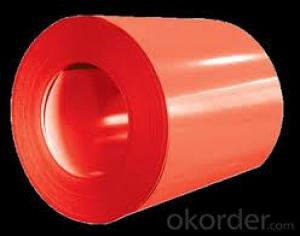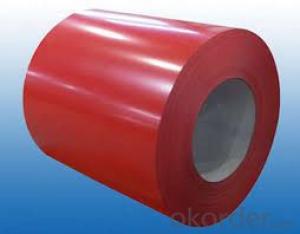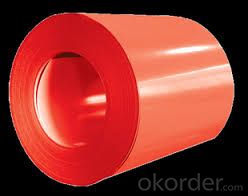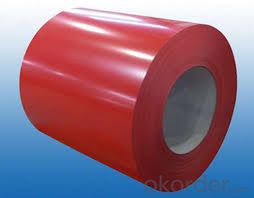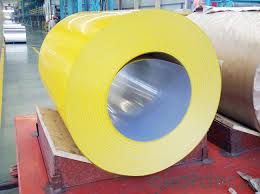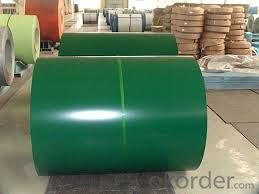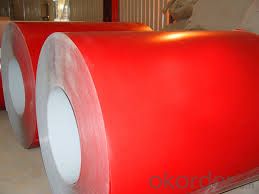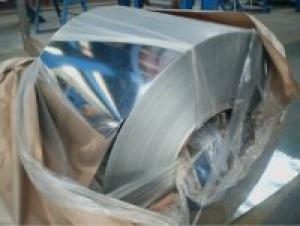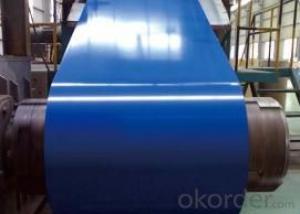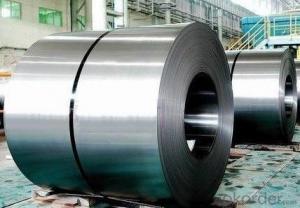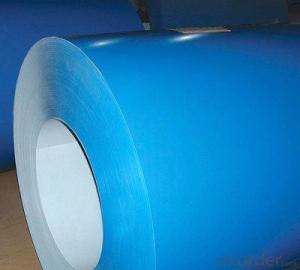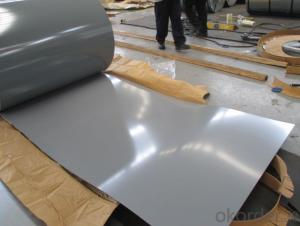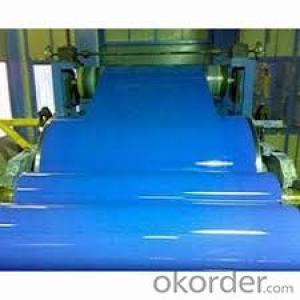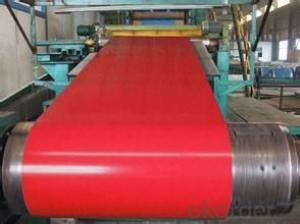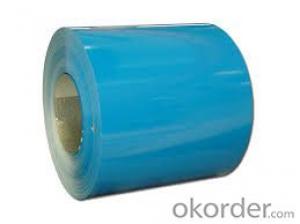Prepainted Galvanized Rolled Steel Coil/Sheet/Plate-CGCC
- Loading Port:
- Tianjin
- Payment Terms:
- TT OR LC
- Min Order Qty:
- 20 m.t.
- Supply Capability:
- 500000 m.t./month
OKorder Service Pledge
OKorder Financial Service
You Might Also Like
Specifications
Thickness: 0.186-0.8mm (BMT) Width: 1000-1250mm |
Zinc Coating: 80-275g/m2 |
Color: According to RAL color fan or as per request |
Internal Diameter: 508mm or 610mm |
Coil Weight : 4-8MT |
Quality : Commercial and structural quality |
Paint : Polyester paint for topside, epoxy for reverse |
Standard: JIS G 3312, ASTM A755M, EN 10169 |
Base Steel Grade: SGCC,SGCD,DX51D+Z,DX52D+Z;S200GD,S220GD,S280GD,S350G D,CS, FS,SS |
Technical Data:
Yield Strength | (Mpa) 280-320 |
Tensile Strength | (Mpa) 340-390 |
Elongation | 20%-30% |
Reverse Impact | 9J |
T-bending | ≥2T |
Pencil Hardness | ≥2H |
Duration Of Salt Spray Test | 500 H |
Bending At 180 Degree | No crack, purling and fraction |
Applications:
It can be widely used in transportation, light industry, civil usage and farming. It is also the perfect building material in construction for making steel roofing,insulation panel, corrugate sheet, facade wall,shutters,T-bar and home appliance.
Packaging & Delivery:
The packing of coils consists of anti-damp paper, PVC film, hardboard paper, steel box, strapped with steel strips, fitted with locks and edge protectors and guarantees the optimal condition of the delivered goods. Each coil can be additionally fitted with wooden/steel skids(eye to the side) or wooden pallets(eye to the sky).
Images:
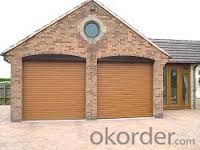
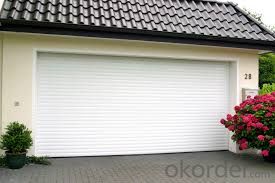
- Q: What is the average surface finish tolerance for steel coils?
- The average surface finish tolerance for steel coils can vary depending on the specific requirements and applications. However, commonly accepted standards for surface finish tolerance in the steel industry range between 10 to 20 microinches (0.25 to 0.5 micrometers).
- Q: i have been playing with hand me down graphite shaft irons and wedges. i was wondering if someone of my stature (5'3, 90 lbs., 12 years old) should be using steel shafted irons. i can definately swing them im just wondering if they are better for making contact
- Steel will give you more consistency as they don't flex as much as graphite but at the same time are less forgiving. Graphite can give you more flex which increases club head speed for distance but you lose some consistency. I would say stick with your current clubs being your only 12yo and will being a lot in the next 5-6 years. You don't want to be stuck at 17yo and 5'10 swinging clubs that are for someone much shorter.
- Q: which metals have a higher density than steel? and how does the density compare to steel( example: tungsten carbide is 2x [i think] more dense than steel.)
- Look at a periodic table of the elements. The atomic weights are a guide to density. Tungsten is denser than tungsten carbide because it doesn't contain carbon. Also denser than steel are gold, lead, platinum, and a number of other metals. Steel is iron combined with lighter elements, so iron is denser than steel.
- Q: What are the dimensions of steel coils used in the automotive industry?
- The dimensions of steel coils used in the automotive industry can vary depending on the specific application, but common dimensions range from 0.5mm to 3mm in thickness and 600mm to 2000mm in width.
- Q: How are steel coils used in the production of food processing equipment?
- Due to their advantageous properties, steel coils find widespread use in the manufacturing of food processing equipment. These coils, typically crafted from stainless steel, are employed in the production of a diverse array of equipment, including mixers, blenders, conveyors, ovens, and fryers. The excellent resistance to corrosion exhibited by steel coils is one of the primary reasons they are preferred for use in food processing equipment. Stainless steel coils possess a high resistance to rust and can endure exposure to moisture and various food substances without deteriorating. This crucial characteristic ensures that the equipment remains hygienic and safe for food processing. In addition, steel coils provide exceptional strength and durability, enabling food processing equipment to withstand heavy use and harsh operating conditions. These coils can be shaped into various forms and sizes, making it possible to fabricate complex equipment components. This versatility facilitates the design and construction of equipment that is both efficient and reliable in processing a wide range of food products. Moreover, steel coils are simple to clean and maintain. The smooth surface of stainless steel prevents staining and simplifies the removal of food residues, thereby preventing the growth of bacteria. Regular cleaning and sanitation of food processing equipment are indispensable in maintaining food safety standards, and steel coils streamline this process, making it more effective. Furthermore, steel coils possess excellent heat conductivity properties, which facilitate efficient heat transfer in food processing equipment, such as ovens and fryers. This allows for precise temperature control and uniform cooking, ensuring consistent quality in the processed food products. In summary, steel coils assume a vital role in the production of food processing equipment by providing corrosion resistance, strength, durability, ease of cleaning, and efficient heat transfer. These qualities render steel coils an ideal material for manufacturing equipment that meets the stringent hygiene, safety, and quality standards required in the food processing industry.
- Q: How are steel coils processed and shaped into various products?
- Steel coils are processed and shaped into various products through a series of manufacturing processes. First, the steel coil is uncoiled and cleaned to remove any impurities. Then, it goes through a process called leveling, where the coil is flattened and straightened. Next, the steel is cut into the desired length or shape, using techniques like shearing or slitting. After that, it may undergo additional processes such as forming, bending, or rolling to give it the desired shape. Finally, the steel is often treated with coatings or finishes to enhance its durability and appearance.
- Q: Can you weld copper or brass to steel?
- This Site Might Help You. RE: Welding question Can you weld copper or brass to steel? Can you weld copper or brass to steel?
- Q: What are the different methods of edge trimming steel coils?
- Manufacturers have various methods at their disposal for edge trimming steel coils, which are chosen based on their specific preferences and requirements. Some commonly used methods include: 1. Slitting: This method involves passing the coil through rotating circular blades to precisely cut the edges. It is suitable for different thicknesses of steel coils. 2. Milling: By using milling cutters, excess material is removed to achieve the desired edge finish. Milling is often employed for thicker steel coils or when a specific edge profile is needed. 3. Shearing: A sharp blade is used to cut the steel coil along a straight line, providing a clean and straight edge. This method is commonly used for thinner steel coils. 4. Laser cutting: Edge trimming is achieved by utilizing a focused laser beam to melt or vaporize the excess material, resulting in a precise and smooth edge. Laser cutting is often preferred for thinner gauges or when intricate shapes or patterns are necessary. 5. Water jet cutting: This method involves a high-pressure stream of water mixed with abrasive particles to trim the edges of the steel coil. Water jet cutting offers a versatile and precise cutting solution, particularly for thicker steel coils and complex shapes. Manufacturers should carefully assess their specific requirements, including coil thickness, desired edge finish, speed, and cost, to choose the most suitable edge trimming method for their steel coils.
- Q: How are steel coils processed for galvanizing or coating?
- Steel coils are processed for galvanizing or coating through a series of steps. First, the coils are cleaned to remove any dirt or oil. Then, they go through a chemical treatment to prepare the surface for coating. After that, the coils are coated with a layer of zinc or another protective material. Finally, the coated coils are cured or heated to ensure proper bonding and adhesion of the coating.
- Q: How are steel coils used in the manufacturing of railway equipment?
- The strength, durability, and versatility of steel coils are crucial factors in their importance in the manufacturing of railway equipment. These coils, typically made from high-quality steel, are extensively used in various applications throughout the railway industry. A primary application of steel coils in the manufacturing of railway equipment is the production of train tracks. By rolling and shaping steel coils into long, continuous rails, the foundation of railway tracks is formed. This allows the tracks to withstand heavy loads, constant train traffic, and harsh weather conditions, thanks to the coils' strength and durability. Moreover, the uniformity and consistency of steel coils ensure smooth and safe train operations. Additionally, steel coils are utilized in the manufacturing of railway wagons and carriages. These coils are shaped into various components, such as the framework, body panels, and structural supports of the wagons. The robustness of steel coils guarantees the structural integrity of the wagons, enabling them to carry heavy cargo and endure the hardships of railway transportation. Furthermore, steel coils find use in the fabrication of various railway equipment accessories, including couplings, brake systems, and suspension components. These coils are shaped and sized precisely to meet the specific requirements of each accessory. The strength and resilience of steel coils make them ideal for these critical parts, ensuring the efficient and safe operation of railway equipment. In conclusion, the role of steel coils in the manufacturing of railway equipment is vital. Their strength, durability, and versatility make them an essential material for constructing train tracks, wagons, carriages, and various accessories. The use of steel coils guarantees the safety, reliability, and longevity of railway equipment, making them an integral part of the railway industry.
Send your message to us
Prepainted Galvanized Rolled Steel Coil/Sheet/Plate-CGCC
- Loading Port:
- Tianjin
- Payment Terms:
- TT OR LC
- Min Order Qty:
- 20 m.t.
- Supply Capability:
- 500000 m.t./month
OKorder Service Pledge
OKorder Financial Service
Similar products
Hot products
Hot Searches
Related keywords
